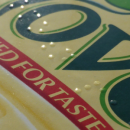
Varnishes and laminates
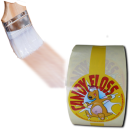
Printing of color labels is most often protected with standard glossy varnish. Varnishes can be standard or very glossy GLOSS. For contact with food, it is recommended to use LOW-MIGRATION and LOW-ODOR varnishes.
APPLICATIONS: Different types of varnish are used for various applications. Most often, varnishing is done to protect the surface from rubbing off the print. Selective decoration of selected elements is becoming increasingly popular. TTR glossy varnishes are suitable for printing on label printers and can also be written on with a pen or marker. High-gloss GLOSS varnishes have a high slipperiness due to their high silicone content and are therefore not suitable for thermal transfer printing - dye transfer paper, inkjet spit or pen.
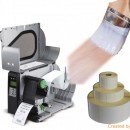
Labels with varnish for thermal transfer printing. For contact with food, it is recommended to use LOW-MIGRATION and LOW-ODOR varnishes. Always test a sample of labels with a given varnish because not all printers tolerate the appropriate dull varnishes (problem of cuts/tugs). TTR varnishes are not recommended for thermal printers. For IML labels, bands, loops, sachets/laminates, fruittags, where slipperiness is important, TTR varnishes that are dull and cause sticking should not be used.
APPLICATION: Most often, varnishing is done to protect the surface from rubbing off the print. The color print is most often protected with varnish. If printing with label printers is expected - dye transfer paper, inkjet, pen - then TTR varnish should be used, which is dull but thanks to its structure allows printing and writing on it. Unfortunately, these varnishes do not have good slipperiness due to their low silicone content.
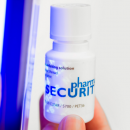
Labels printed with security features such as invisible fluorescent varnish. The best and cheapest solution that meets the security function is varnish that glows blue under UV light. This is a specialist solution at the customer’s special request. There are also special types on the market, such as thermochromic paints (which change color under the influence of temperature), coin paints (which change color when rubbed with a coin), or black IR (allowing IR rays to pass through). For economic and technological reasons, securing products with invisible printing is only gaining momentum in Poland. Printers must have specialized equipment and certification to be able to print and control it.
APPLICATION: An example of the use of labels with invisible printing are: wrap-around labels on bottles in Germany, which are printed with a special fluorescent varnish. Such protection prevents such labels from being counterfeited. All this is because the product, which is a plastic bottle for drinks, is subject to recycling and a deposit is returned for its transfer.
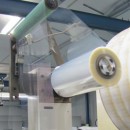
Laminated labels. Lamination involves covering the printed label with a thin layer of film. It protects against mechanical damage, corrosive substances and dirt. The use of laminating film causes the label to thicken and stiffen. Matte and standard GLOSS shiny films can be laminated. Popular film thicknesses for lamination are BOPP 15, 20, 25 and 30 microns. Lamination is carried out over the entire surface, it cannot be selective.
We offer a UV-protected LAMINATE that protects the print from fading.
APPLICATION: Lamination is a more expensive alternative to varnishing with UV varnishes. A combination of matte laminate and glossy varnish is often used, where the glossy varnish is selectively applied (with a polymer) to elements that are to be more visible, printed on a matte laminate BACKGROUND (over the entire surface from the roller). This creates a convex effect. Laminates better protect surfaces from damage than varnishes alone. Lamination is most commonly used to thicken laminates used for PACKAGING.

Labels with matte varnish are less popular and less frequently used than glossy ones. Varnishing with matte varnish is an economical way of decorating labels, slightly more expensive than varnishing with GLOSS shine varnish. Matte varnishes also include SOFT-TOUCH varnish, which is distinguished by its delicate touch. Matte varnishes also come in standard and LOW-MIGRATION versions with a food contact certificate.
APPLICATION: They are mainly used to protect color printing (partially selectively or completely from the roller). They protect the print from abrasion.

















